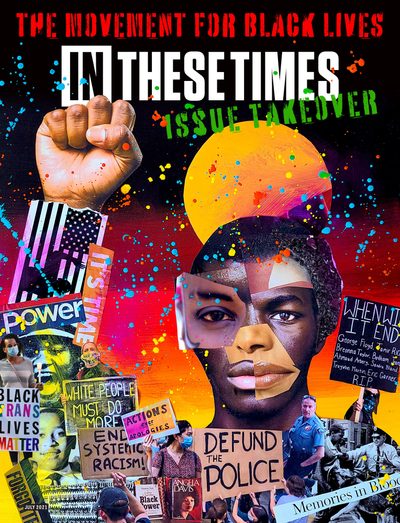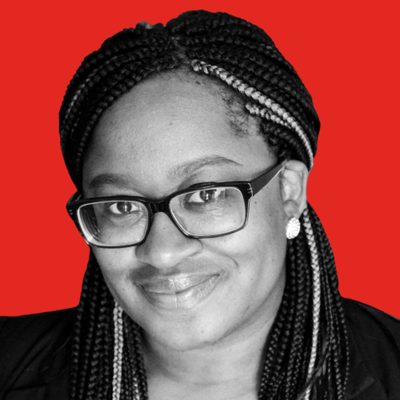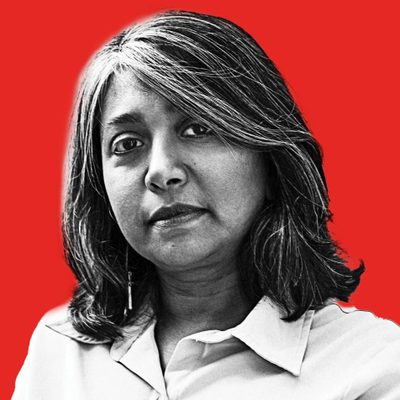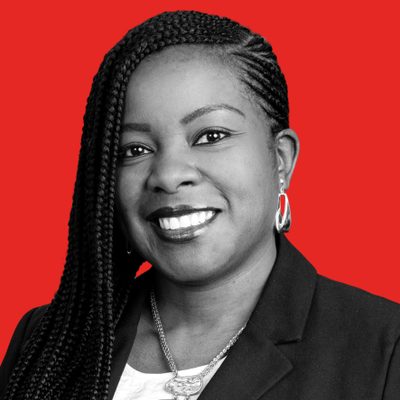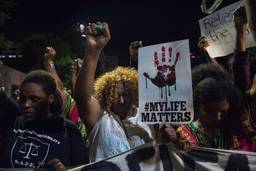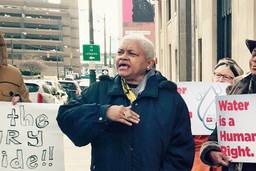What Radical Black Women Can Teach Us All About Movement-Building
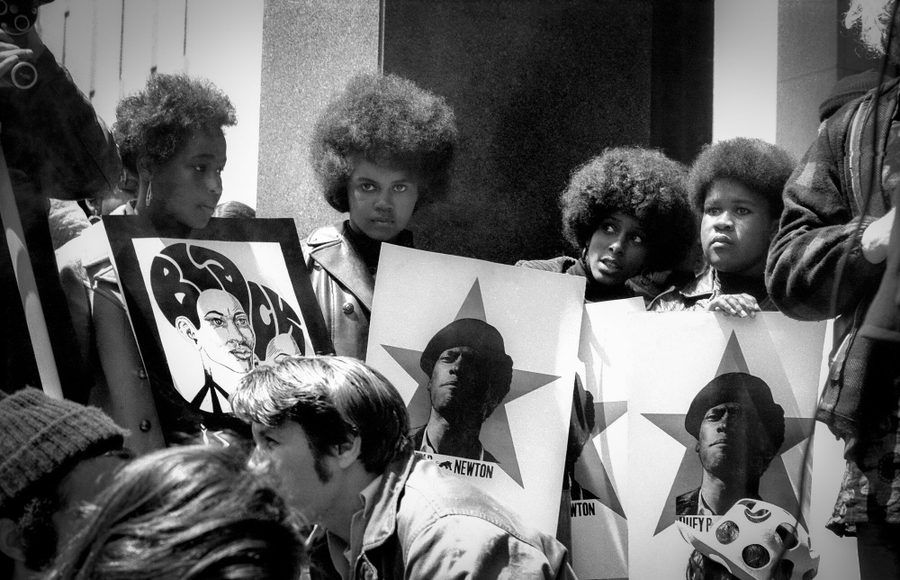
Black women supporting the Black Panther Party hold images of the group’s co-founder Huey P. Newton on May 1, 1969, in San Francisco. Robert Altman/Michael Ochs Archives/Getty Images
Three historians lift up Black women journalists, organizers and activists who were critical to Black freedom movements but often erased from history.
The Movement for Black Lives is noteworthy for a leadership that is overwhelmingly women (both cis and trans). Although not always recognized, Black women’s organizing, insights and analysis have long been an engine of Black freedom movements. That is no accident: As the Combahee River Collective, a collective of Black feminist socialists, write in their groundbreaking 1977 statement, “We believe that the most profound and potentially most radical politics come directly out of our own identity.” They saw the particular task of Black feminists as “the development of integrated analysis and practice based upon the fact that the major systems of oppression are interlocking.”
In These Times and the Movement for Black Lives guest editors asked distinguished historians of the Black experience to lift up the Black women in movements that presaged the Movement for Black Lives. In this roundtable, professors Premilla Nadasen, Keisha N. Blain and Robyn C. Spencer offer snapshots of chapters of Black struggle that provide inspiration and grounding for the work of the 21st century Black freedom movement.
Nadasen reminds us that there was intersectional Black feminist practice before it had a label. Poor Black women in the welfare rights movement were justice crusaders who, in their campaigns, speeches and demands, reflected an understanding of the confluence of different systems of oppression. Blain recovers a powerful lost chapter in the history of Black radicalism in Detroit by retelling the story of internationalist and anti-racist organizer Pearl Sherrod. Spencer, herself an outspoken proponent of Black and Palestinian solidarity, adds the story of Black Panther Connie Matthews, another lesser-known exemplar of Black internationalism in the 1970s.
This recuperative process of remembering Black women in the Black freedom struggle is more than celebratory. It is a reminder that the real, hard work of movement-building and freedom-making is not going to be done by celebrities, or even politicians — but by ordinary people with deep passions, strong commitments and clear visions.
—Barbara Ransby
In what ways have Black women historically pioneered a radical, transformative politics?
PREMILLA NADASEN: Poor Black women have waged a generations-long, often overlooked struggle for economic autonomy against a patriarchal, racist capitalist system stacked against them. The welfare rights movement of the 1960s and 1970s is an underrecognized example of the deep contestation of this system through a radical Black feminist vision.
Established during the Great Depression, the welfare system catered to “worthy” white widows with provisions aimed at denying assistance to “undeserving” Black mothers, forcing them to remain in the labor force rather than be full-time caregivers for their own children. The legislation excluded the farm and domestic sectors that were dependent on Black women’s underpaid labor. In a 1939 report, a welfare field supervisor in the South wrote that welfare officials see no “reason why the employable Negro mother should not continue her usually sketchy seasonal labor or indefinite domestic service rather than receive a public assistance grant.”
Even as civil rights activists worked to dismantle discriminatory welfare provisions in the 1960s — enabling more Black women to gain access to benefits — new regulations required that recipients take paid employment outside the home.
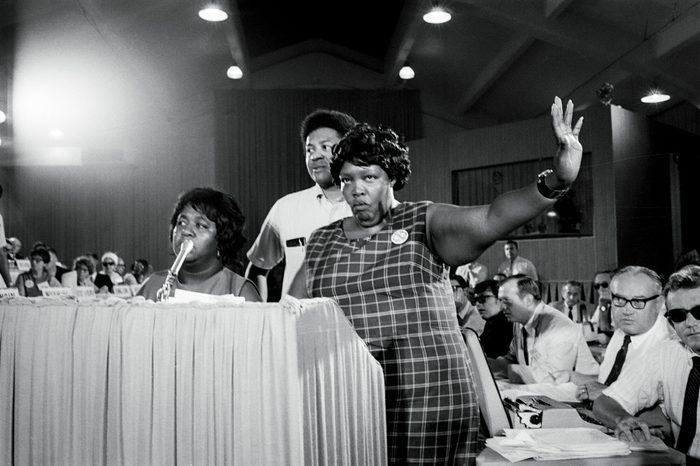
African American and other poor women of color contested this injustice in the 1960s and 1970s. Following in the radical tradition of Sojourner Truth, they asserted their womanhood and claimed the same treatment afforded white women. The changes they demanded spanned from improved welfare benefits and participation in decision-making to access to abortion and the end of coerced sterilization.
The most far-reaching demand of the welfare rights movement was for a guaranteed annual income that would bring all poor people — regardless of race, gender, family status, legal status, employment status — up to a minimum standard of living well above the poverty line. Welfare rights activists sought to dismantle the economic status quo predicated on Black women’s low-wage work, which maintained joblessness and a reserve army of labor for capital. Instead, they envisioned substantive access to freedom, autonomy and self-determination for poor Black mothers.
ROBYN C. SPENCER: Black women acted as leaders and the organizing backbone of the Black liberation movement of the 1960s and 1970s. Like the welfare rights movement — itself a form of Black liberation — their political work reflected an ethos of radical care that included mutual support around bodily autonomy and childcare, as well as a commitment to eradicating poverty and racism. Other focal points were concern for male draftees and political critiques of U.S. empire and state violence.
The Black Panthers, the most well-known of the 1960s Black Power organizations, elevated the profiles of many Black men fighting the white supremacist system, but quietly relied on Black women’s organizing work. From food distribution to health clinics around the country, Black women played an instrumental role in supporting the Panthers’ community programs to fill desperate needs and gain support for their political vision. Black women were concerned with political theory around Black liberation while being attendant to immediate human needs. I am reminded of Kayla Reed’s Viewpoint about the Movement for Black Lives (M4BL) supporting candidates and policies that meet immediate “material conditions.”
The arrest of Black men in the Party opened up space for women in leadership, such as Kathleen Cleaver, who joined the Oakland Panthers in 1967 when their ranks had been depleted locally by a wave of arrests. As communications secretary, Cleaver orchestrated the Free Huey movement that turned the arrest of Panther cofounder Huey Newton into a cause célèbre. Behind the images of Panther women rallying for Newton was the work that Cleaver and other Black women did to mobilize and educate the masses about what Newton and the Panthers stood for.
While Panther women (and allied men) held the organization accountable to its stated commitment to internal transformation and egalitarian gender roles, they also faced persistent sexism from many of their fellow Black Power organizers. The unique perspective Black women brought to Black liberation, along with the frustration at their treatment within the movement, would grow in the 1970s into new forms of Black feminist organizing and thought — such as the Combahee River Collective statement. It acknowledges that their “experience and disillusionment within these liberation movements, as well as experience on the periphery of the white male left, that led to the need to develop a politics that was anti-racist, unlike those of white women, and anti-sexist, unlike those of Black and white men.”
Despite Black women’s immense contributions, even today — a time of unprecedented awareness of the Panthers — their work within the organization remains hidden by a focus on male leaders’ advocacy of self-defense above and beyond any other legacy.
I see parallels in the Black Lives Matter movement— although, in this case, visibility of women is not hidden behind prominent male leaders. Rather, the work of the Black women who launched the initial call and the large number organizing at the grassroots — often to defend the lives of Black men, as with the Panther women — is hidden in plain sight, eclipsed by political abstractions.
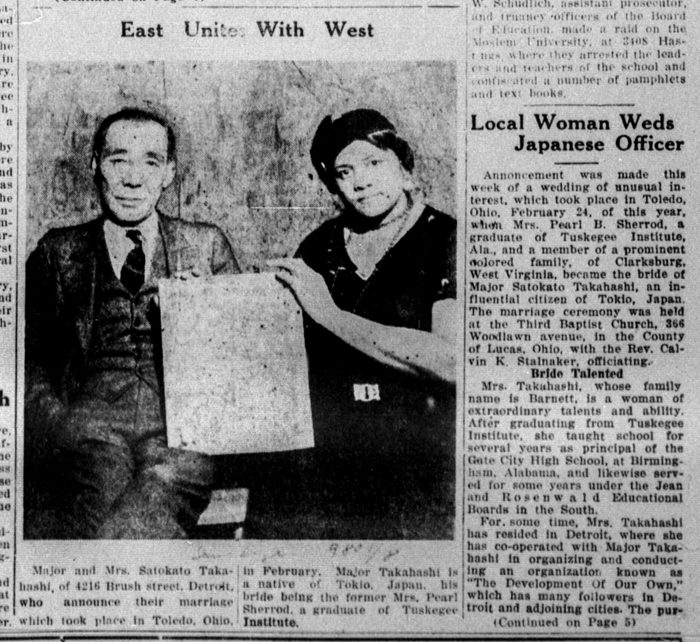
KEISHA N. BLAIN: There is also a legacy of radical Black women organizers who bridged Black radicalism and feminism decades before the Black Panthers, the Combahee River Collective or the M4BL. As a scholar of 20th century U.S. history, my research has focused on bringing these women to light, whose impact on domestic and international politics has been largely ignored.
Pearl Sherrod is one example. She was a working-class Black woman in 1930s Detroit, a journalist-activist in the tradition of anti-lynching crusader Ida B. Wells. Sherrod went from a local newspaper to an international platform in her fight against the continued “barbequing and torturing of our race in the South.”
Sherrod used the Detroit’s Tribune Independent to denounce white supremacy and demand its eradication, bringing light to Black Americans’ struggles with economic distress and racist violence during the Great Depression. Like the Panther women who followed her, Sherrod took risks in standing up to defend Black men’s lives. In 1934, Sherrod openly criticized the U.S. criminal justice system, pointing to the mistreatment of the Scottsboro Boys — nine Black teenagers who were falsely accused of sexually assaulting two white women in Scottsboro, Ala.
Sherrod also called for Afro-Asian solidarity, highlighting their shared suffering at the hands of white supremacy. White hostility to and violence toward Asian immigrants (known as the “yellow peril”) surged during the Depression. In 1937, Sherrod took her message to the conference of the Pan-Pacific Women’s Association (PPWA). Held in Vancouver, Canada, the conference brought together 125 mostly white and Asian women representatives from eight countries: Australia, Canada, China, Hawai’i, Japan, New Zealand, the Philippines and the United States. Sherrod was not invited — no Black women were, nor had ever attended — but she showed up anyhow with newspaper clippings to call the attention of “you international women” to the prevalence of lynching in the U.S. South. “To the Black man, justice is only a word in name but not in reality,” Sherrod declared.
Sherrod’s move to an international stage is really interesting. Can you expand on Black internationalism?
BLAIN: Black internationalism emerged in response to slavery, colonialism and white imperialism. It describes the visions of freedom and freedom movements among people of African descent worldwide and captures their efforts to forge transnational collaborations and solidarities with other people of color.
Sherrod viewed alliances with Asian activists as vital to the global project to achieve rights and freedom for people of African descent everywhere. In 1934, Sherrod married Satokata Takahashi, a Japanese immigrant, and took over his leadership of The Development of Our Own (TDOO), a Detroit-based Afro-Asian solidarity movement, upon his deportation to Japan later that year.
The first African American to ever speak at a PPWA conference, Sherrod proclaimed: “There can never be peace on the Pacific or Atlantic until justice is given to all mankind.”
In this early expression of Black internationalism, Sherrod recognized that domestic conditions — such as economic hardship and the attacks against various racial groups — provided grounds for connecting subjugated people worldwide. They were part of the same antiracist and anticolonial struggle.
SPENCER: Indeed, after the murder of George Floyd in May 2020, Black Lives Matter protests erupted not only across the United States but in over 60 countries. This expression of global solidarity builds on the grid wired by activists like Sherrod — or Connie Matthews, the Black Panther Party international coordinator from 1968 – 1971.
Matthews spoke at rallies against the U.S. war in Vietnam and, like Sherrod, emphasized connections between the oppression in Asia and African decolonization as part of the same global struggle. She skillfully mobilized a far-flung network of international alliances to provide support for incarcerated Panthers at the height of COINTELPRO.
Matthews is another example of the way Black women’s work has shifted abstract concepts like solidarity into actionable political work. She organized people willing to act, making links with leftist organizations and giving interviews with the European press to share the Panther vision. By mid-1969, her activities had laid crucial groundwork for the creation of solidarity committees in Germany, France, Holland, Norway and Sweden to support Panther political prisoners. Her legacy can be felt in groups like the Organization for Black Struggle, the Malcolm X Grassroots Movement and Black for Palestine.
In 2015, the Dream Defenders, an organization founded in Florida after the killing of 17-year-old Trayvon Martin, brought representatives from Ferguson, Black Lives Matter and the Black Youth Project 100 to see conditions on the ground in Palestine first hand. Each successive wave of struggle builds on these prior connections. In the wake of the bombings in Gaza in May, the M4BL and other BLM groups swiftly denounced the attacks and ongoing settler-colonialism in the West Bank.
That initial 2015 trip was explicitly inspired by the internationalism of the Black liberation movement. As Ahmad Abuznaid, who at the time served as legal and policy director for the Dream Defenders, explained: “In the spirit of Malcolm X, Angela Davis, Stokely Carmichael and many others, we thought the connections between the African American leadership of the movement in the U.S. and those on the ground in Palestine needed to be reestablished and fortified.”
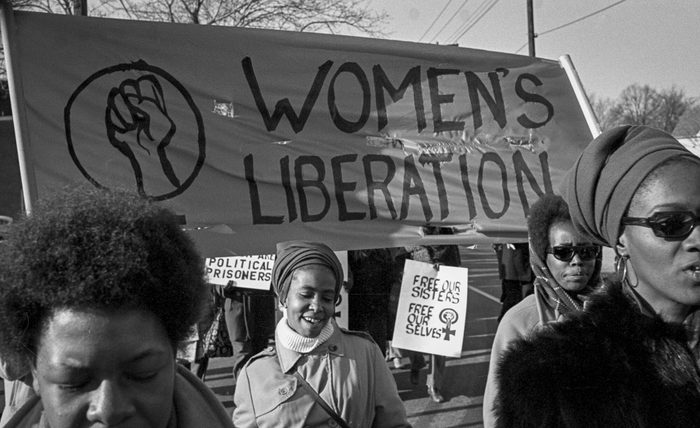
What other lessons can the M4BL take from these historical movements?
SPENCER: Despite all the institutions the Black Panther movement built and the change it envisioned and achieved, it was riven by ideological disagreements and power struggles that the government exploited to attack the movement. The FBI’s COINTELPRO program stoked divisions through misinformation, surveillance, raids, arrests, infiltration, harassment and violence (including its role in the 1969 assassination of Fred Hampton). The return of co-founder Huey Newton in 1970 after two years in prison exacerbated longstanding tensions around money, the role of local leadership and ideological differences about self-defense. Disagreement over whether to adopt violent tactics in response to government repression precipitated a schism between Newton and fellow Panther leader Eldridge Cleaver. Many chapters left, were expelled or dissolved, and new groups were created that centered armed struggle, like the Black Liberation Army and the Revolutionary People’s Communications Network.
Under Trump, the Movement for Black Lives saw for itself how a hostile government can brand racial justice organizers as threats (and turn the apparatus of the state against them), or how tensions can erupt over questions of the acceptability of property damage and self-defense. Managing internal conflict and dissent with integrity — in the face of a hypercritical media and right-wing institutions eager to spotlight so-called cracks in the facade — remains a challenge.
Organizations today exist in a time of surveillance infrastructure, militarized policing and a different landscape of political repression — and must protect against this reality. But they also have a direct line to the public, through social media, to challenge misinformation.
Black Lives Matter has adopted group-centered leadership in the tradition of Ella Baker, calling itself “leader-full.” In contrast to the hierarchical Panther leadership structure dominated by cis men, the community of BLM’s many leaders is filled with women and trans, non-binary and intersex folks. Even within this success, it has to balance its critique of charismatic leadership against strict organizational hierarchy, while also dealing with power dynamics that control resources. The recent eruption over money in the Black Lives Matter Global Network Foundation echoes issues that plagued the Panthers, highlighting fissures that might imperil momentum.
Looking back, the ability to weather political storms and commit to the longue durée might be the most important lesson. Black liberation does not hinge on individuals, dramatic moments or turning points. The ability to pivot and adapt, transcend human failings and work through internal dissent — because of love of the people and commitment to the goals — is one of the key lessons of the past.
NADASEN: The welfare rights movement’s wide-ranging demands were designed to revalue and reinvest in Black families and communities. Activists sought to shift state resources to childcare, employment, healthcare and education to bolster community well-being. As welfare programs have become increasingly punitive over the past three decades, redirection from the carceral state to communal care is more important than ever.
The M4BL “invest” demands to defund police and reinvest in community services follow this legacy.
Although welfare rights activists were not explicitly anti-capitalist — they might be viewed as accommodationist in demanding access to state benefits, rather than opposing the state itself — their insistence on having the option to care for their families struck a blow to a racialized-gendered economic system that is reliant on their low-wage labor. The movement offers lessons about leveraging the state to remake the programs that control and surveille — like those used against the Panthers — into ones that reinvest to give people autonomy and sustain their communities. In this regard, they sought to make all Black lives matter.
The welfare rights movement models a radical Black feminist politics that brought together poor women of all racial backgrounds around economic justice and autonomy. Working side by side, they recognized how racism was deployed to demonize and divide poor women — making their class analysis explicit.
“[The National Welfare Rights Organization] is not a black organization, not a white organization,” argued Johnnie Tillmon, welfare recipient and organization chair, in a 1971 interview. “We can’t afford racial separateness. I’m told by the poor white girls on welfare how they feel when they’re hungry, and I feel the same way when I’m hungry.”
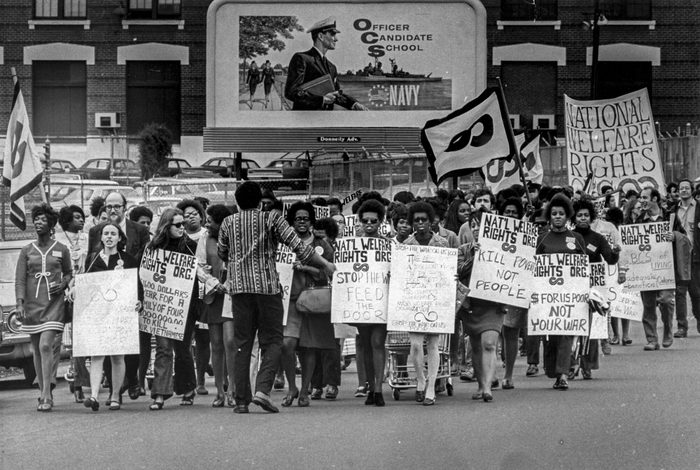
BLAIN: Like Tillmon with the NWRO, Sherrod and the PPWA provided an opportunity for Black, Asian and white women to work in shared struggle. Sherrod’s bold stance — showing up uninvited and speaking at the PPWA conference — opened up a crucial space for women of African descent to engage in political dialogue with the mostly white and Asian membership. Sherrod built a political alliance and gained a broader platform to denounce global white supremacy.
If Sherrod’s experiences offer one lesson, it is that continued transnational efforts to frame anti-Black racism as an international human rights issue will help ensure the movement’s vitality and sustainability.
Nearly 80 years after that PPWA conference, on July 12, 2016, Nigerian American activist Opal Tometi, co-founder of Black Lives Matter, delivered a powerful speech before the United Nations General Assembly on the heels of the police killings of two Black men, Alton Sterling and Philando Castile. An invited speaker, Tometi echoed Sherrod in emphasizing three challenges to the advancement of human rights for all: global capitalism, white supremacy and the suppression of democracy.
To quote Tometi, all three grow from the “root causes of inequality,” shaped by a history of “colonialism, indigenous genocide and the enslavement of people of African descent.” That Tometi’s message so closely resembles the words of another Black woman activist, from 1937, underscores the persistence of the structural problems we face and the tenacity of Black women in rooting them out and fighting for transformation.
Keisha N. Blain is associate professor of history at the University of Pittsburgh and president of the African American Intellectual History Society. Her latest books are Four Hundred Souls: A Community History of African America, 1619-2019 (with Ibram X. Kendi) and Until I am Free: Fannie Lou Hamer’s Enduring Message to America.
Robyn C. Spencer is a historian focused on Black social protest after World War II, urban and working-class radicalism and gender. She co-founded the Intersectional Black Panther Party History Project and authored The Revolution Has Come: Black Power, Gender, and the Black Panther Party in Oakland.
